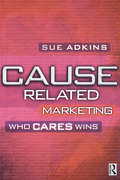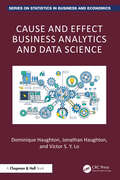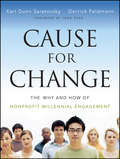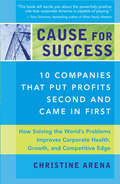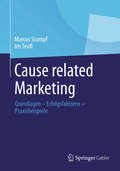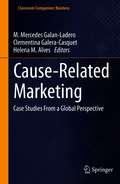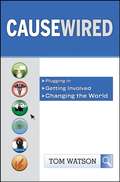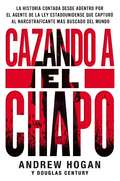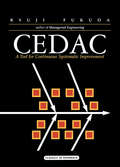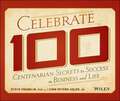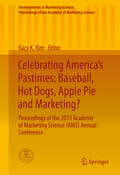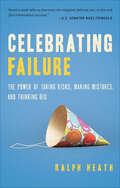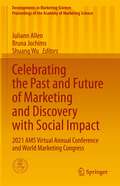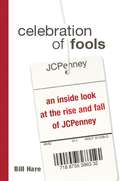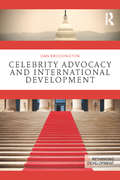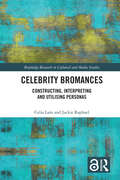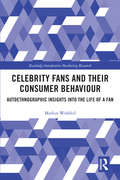- Table View
- List View
Cause Related Marketing: Who Cares Wins
by Sue AdkinsCause Related Marketing's time has come. Consumers are demanding greater accountability and responsibility from corporations. In an environment where price and quality are increasingly equal; where reputation and standing for something beyond the functional benefits of a product or service is all, brands are constantly competing for customer loyalty and consumer attention. 'Cause Related Marketing' is one of the most exciting areas in marketing today which benefits both business and society. 'Cause Related Marketing': * positions Cause Related Marketing in the context of marketing, corporate social responsibility and corporate community investment.* explores who cares and why, providing research analysis into corporate and consumer attitudes both in the UK and internationally.* uses The Business in the Community Cause Related Marketing Guidelines, written by Sue Adkins and introduced by HRH The Prince of Wales, providing an in depth exploration of the key principles and processes that go towards creating excellence in Cause Related Marketing.* includes vignettes and in depth case studies to provide illustrations of Cause Related Marketing through a spectrum of examples both national and international. Sue Adkins, Director of the Business in the Community's Cause Related Marketing Campaign is acknowledged as an international expert. She is recognised as having put Cause Related Marketing on the map in the UK and leading the drive to establish Cause Related Marketing as an increasingly legitimate part of the marketing mix in the UK.
Cause and Effect Business Analytics and Data Science (Chapman and Hall/CRC Series on Statistics in Business and Economics)
by Jonathan Haughton Dominique Haughton Victor S. LoAmong the most important questions that businesses ask are some very simple ones: If I decide to do something, will it work? And if so, how large are the effects? To answer these predictive questions, and later base decisions on them, we need to establish causal relationships.Establishing and measuring causality can be difficult. This book explains the most useful techniques for discerning causality and illustrates the principles with numerous examples from business. It discusses randomized experiments (aka A/B testing) and techniques such as propensity score matching, synthetic controls, double differences, and instrumental variables. There is a chapter on the powerful AI approach of Directed Acyclic Graphs (aka Bayesian Networks), another on structural equation models, and one on time-series techniques, including Granger causality.At the heart of the book are four chapters on uplift modeling, where the goal is to help firms determine how best to deploy their resources for marketing or other interventions. We start by modeling uplift, discuss the test-and-learn process, and provide an overview of the prescriptive analytics of uplift.The book is written in an accessible style and will be of interest to data analysts and strategists in business, to students and instructors of business and analytics who have a solid foundation in statistics, and to data scientists who recognize the need to take seriously the need for causality as an essential input into effective decision-making.
Cause for Change: The Why and How of Nonprofit Millennial Engagement
by Kari Dunn Saratovsky Derrick FeldmannA nonprofit leader's guide for engaging millennials in all aspects of a nonprofit organization Written by Millennials about Millennials, Cause for Change examines strategies for engaging Millennials as constituents, volunteers, and donors, and focuses on how organizations can realign themselves to better respond to this group of 80 million strong. At the heart of this research-based guide is the Millennial Development Platform, an action-based rubric developed by the authors and included in each chapter to help organizations create the infrastructure for a long-term millennial engagement strategy. Examines how Millennials communicate, volunteer, take action, influence their peers, and choose to give their time and money Explains how Millennials view their role in the workplace, and how their approach is re-shaping nonprofit culture from within Cause for Change profiles Millennials who have emerged as dynamic leaders to create and manage movements in their communities.
Cause for Success
by Christine ArenaStung by corporate scandals and media mayhem, many companies have begun integrating terms like "sustainable business," "conscious capitalism," and "ethical business" into their annual reports. Is it more corporate greenwashing or are businesses today really changing how and with whom they do business? Can corporate social responsibility become a new business standard? When it comes to implementing the kind of business strategies that create vital social and economic returns, many corporate leaders find themselves at a loss. "This is because, unlike branding or accounting, there are far too few solid industry case studies that profile the success stories and how those companies got there," says author and award-winning marketing specialist Christine Arena. Arena finds reasons to be optimistic while she examines new business paradigms for doing good and translating that good into profit. From Hewlett-Packard to British Petroleum to Stonyfield Farms and The Body Shop, Cause For Success profiles two case-study companies per chapter, exploring ideas such as philanthropy partnerships, ethics-driven businesses, how companies are serving the world's poor, bottom-line advantages of standing for social justice, as well as how some of the worst corporate citizens have become some of the best.
Cause related Marketing: Grundlagen - Erfolgsfaktoren - Praxisbeispiele
by Marcus Stumpf Iris TeuflCause related Marketing (CrM) bezeichnet die Zusammenarbeit eines Unternehmens mit einer Non Profit-Organisation. Dazu zählt z. B. eine Unternehmenskampagne, die den Verkauf eines Produktes an eine Spende für eine ,,gute Sache" koppelt. Marcus Stumpf und Iris Teufl ordnen den Begriff in den Themenbereich der Corporate Social Responsibility (CRS) ein und grenzen ihn von verwandten Begriffen ab. Die Autoren zeigen Chancen sowie Risiken bei der Implementierung auf und arbeiten die Erfolgsfaktoren für einen zielgerichteten Einsatz von CrM heraus. Konkrete Implikationen für die Unternehmenspraxis werden vorgestellt. Zur Veranschaulichung beschreiben sie detailliert CrM-Kampagnen sowohl aus Sicht von Profit-Unternehmen als auch aus Sicht sozialer Organisationen - wie z. B. Brauhaus Jever, Erdal/Frosch, Rotes Kreuz, Volkshilfe sowie WWF.
Cause-Related Marketing: Case Studies From a Global Perspective (Classroom Companion: Business)
by M. Mercedes Galan-Ladero Helena M. Alves Clementina Galera-CasquetThis textbook uses a case study approach to present a variety of cause-related marketing campaigns that have been developed by companies, and NGOs. These innovative case studies help students understand how such campaigns affect for-profit and non-profit organizations, customers, and society in general. This book also offers numerous useful examples to understand the theory of cause-related marketing and how it can be applied in different countries and cultural contexts. Lecturers will find the teaching notes provided with each case useful for the classroom.
CauseWired
by Tom WatsonNow in paperback, an eye-opening guide to the massive societal impact of online social networksFor today's super-wired, always-on, live-life-in-public young Americans, the causes they support define who they are. Societal aspirations have so permeated the "net native" population that causes have become like musical tastes. CauseWired illustrates wired causes in action, bringing real-world stories to readers.Tracks the massive societal impact on causes of online social networks-from blogs, to video, to the rise of social networksReveals the extraordinary influence of online social networks-in raising money for charity, in changing the political climate and electing candidates, and in raising consciousness for causesFrom Facebook causes and campaigns on MySpace, to a raft of new startups and innovative projects like Kiva, Change.org and DonorsChoose, this immensely relevant book delivers actionable research and recommendations to help readers launch their own successful wired social campaigns.
Causes and Symptoms of Socio-Cultural Polarization: Role of Information and Communication Technologies
by Israr Qureshi Babita Bhatt Samrat Gupta Amit Anand TiwariThis book explores cultural polarization resultant decline in social cohesion in society and how information and communication technologies exacerbate the cultural polarization through phenomenon such as “echo chambers” of information that damage the quality of online discourse. This book examines the nature of the information that is shared. Further this book identifies how the quality of online discourse and polarization induced through it leads to offline harm and negative outcomes in our society. This book discusses how wide-ranging information exchange on digital media can lead to two scenarios, namely, the formation of the public sphere or the formation of echo chambers. While the public sphere, which promotes greater diversity, is a well-researched domain, substantially less research has been conducted on echo chambers in relation to sociocultural activities, products or services. This book states that polarization induced by the formation and evolution of echo chambers in sociocultural realm such as around epidemic outbreaks, vaccination, healthcare, education, and climate change is an emerging avenue of research due to its enormous impact in the shaping of our society. Therefore, this book argues that understanding the characteristics of sociocultural products related controversies is critical and valuable in developing interventions to reduce unhealthy societal and organizational polarisations. The development of systematic knowledge is required to understand and address such a large scale and complex societal challenge so as to facilitate a deeper understanding and offer solutions to the growing issue of polarization in sociocultural context driven primarily through echo chambers. This book examines how technology enabled social media usage increases, and the complex structural outcomes such as echo chambers are likely to have an increasingly important role in shaping public opinion. This book appeals to readers with interest in developing a deeper and broader understanding of issues and initiatives related to the polarization of opinions on cultural products. These include readers and scholars from various disciplines, along with engaged organizational leaders, activists, policy makers, and common citizens.
Causes, Benefits, and Risks of Business Tax Incentives
by Alexander KlemmA report from the International Monetary Fund.
Cazando a El Chapo: La historia contada desde adentro por el agente de la ley estadounidense que capturó al narcotraficante más buscado del mundo
by Douglas Century Andrew HoganUna combinación de las películas Manhunt, Killing Pablo y Zero Dark Thirty, esta sensacional obra de misterio, y de alta tecnología de investigación, de Andrew Hogan y Douglas Century —que pronto será una gran película producida por Sony— es una crónica impresionante de un capítulo en la guerra contra las drogas en el siglo veinte: la experiencia exclusiva de un agente federal estadounidense y sus ocho años de cacería tras El Chapo — el capo de la droga más buscado del mundo, que evadió a la ley por más de una década.Toda generación tiene un criminal: Jesse James, Billy the Kid, John Dillinger, Al Capone, John Gotti, Pablo Escobar. Pero cada uno de estos notorios delincuentes tenía a un investigador rastreando sus pasos: Wyatt Earp, Pat Garrett, Eliot Ness, Steve Murphy. Para el señor de la droga, Joaquín Archivaldo Guzmán, Loera, mejor conocido como “El Chapo”, ese policía es Andrew Hogan, exagente especial de la Drug Enforcement Administration (Oficina de Control de Drogas; DEA, por sus siglas en inglés).En el 2006, recien graduado de la Academia de la DEA, Hogan se dirige a Arizona, en donde rápidamente se encuentra dentro de una serie de espeluznantes casos encubiertos, que lo coloca, sin darse cuenta, tras la pista de Guzmán, el jefe del cártel de Sinaloa, un multimillonario según Forbes, y enemigo público # 1 de Estados Unidos. Seis años después, como jefe de la Oficina de la DEA en la ciudad de México a cargo del cártel de Sinaloa, Hogan se da cuenta que su vida y la del Chapo están irónicamente, en sendas paralelas: ambos se obsesionan por los detalles.En una nueva versión de los clásicos del oeste, pero a escala mundial, Cazando a El Chapo relata la búsqueda de Hogan por lograr lo que parecía imposible, desde infiltrarse en el círculo íntimo de El Chapo, a dirigir una cacería humana con una brigada elite de oficiales de la marina mexicana; derribando una a una las fortalezas del cartel, y en última instancia llevando al Chapo a la justicia.Este relato cinematográfico que narra la implacable investigación de Hogan y su equipo se desarrolla a gran velocidad, llevando al lector trás bastidores en una de las operaciones antinarcóticos más sofisticadas y peligrosas en la historia de Estados Unidos y México.
Caída libre: El libre mercado y el hundimiento de la economía mundial
by Joseph E. StiglitzLas claves para entender la nueva economía que emergerá de la crisis. La llamada Gran Recesión ha afectado a más personas que ninguna otra crisis desde la Gran Depresión. En Estados Unidos, las políticas públicas deficientes y una falta de escrúpulos generalizada han favorecido el desastre financiero actual, cuyo contagio al resto del planeta ha sido devastador. Quién mejor que Joseph Stiglitz para diagnosticar una situación tan compleja de un modo tan accesible. Sus consideraciones acerca del nuevo papel que deben asumir gobiernos y mercados, de la urgente necesidad de regulación y del distinto modo en que se debería gestionar la globalización tienen un peso especial dentro de la batalla de ideas que conformará el «nuevo mundo» destinado a emerger de esta crisis. Caída libre da voz a todas esas personas que vieron indignadas cómo Wall Street acababa con hogares y empleos; cómo los gobiernos fueron incapaces de frenar la crisis y no dieron más pasos de los estrictamente necesarios; cómo los banqueros se contradecían pidiendo que el Estado les sacara del apuro al mismo tiempo que se oponían a una regulación menos propicia a futuras crisis. Stiglitz ofrece alternativas para lograr una economía próspera y una sociedad moral para el futuro. La crítica ha dicho...«Stiglitz es quizá lo más parecido que tenemos a John Maynard Keynes, tanto en su perspectiva teórica como en sus convincentes críticas a quienes dictan las políticas económicas. En Caída libre aplica su formidable mente a analizar cómo las teorías erróneas y las políticas desacertadas nos trajeron el peor crack desde la Gran Depresión.»BusinessWeek «Un enérgico ataque a Wall Street, el libre mercado y el consenso de Washington.»The Times «Caída libre es de lectura imprescindible para todo el que busque comprender las raíces de la crisis financiera.»Boston Globe
Cedac: A Tool for Continuous Systematic Improvement
by Ryuji FukudaWhen you're trying to improve quality and productivity, it's essential to target the right problems, get the right people involved in solving them, and make sure the solutions work. CEDAC will help you do all three. CEDAC, or Cause-and-Effect Diagram with the Addition of Cards, is a modification of the ""fishbone diagram,"" a standard QC tool. One of the most powerful, yet simple problem solving methods to come out of Japan (Fukuda won a Deming Prize for developing it), CEDAC actually encompasses a whole cluster of tools for continuous systematic improvement.They include: Window analysis for problem identification.The CEDAC diagram for problem analysis and development of standards.Nearly 50 illustrations and sample forms suitable for transparencies.Window development for ensuring adherence to standards.Here, in his own words, is Fukuda's how-to manual for the in-house support of improvement activities using CEDAC. Previously available only to his own clients, it provides step-by-step directions for setting up and using CEDAC. With a text that's concise, clear, and to the point. The manual is an ideal training aid.
Cedar Environmental: Innovation vs. Corruption in Lebanon?
by Nien-He Hsieh Youssef Abdel AalThe case follows Ziad Abi Chaker, founder and CEO of Cedar Environmental, an environmental engineering company in Lebanon, as he weighs his options for how to grow the company despite facing barriers to growth, most notably the prevalent public corruption in his industry which he refused to participate in. Abi Chaker had established Cedar Environmental soon after the Lebanese Civil War with a vision of introducing a "Zero-Waste" concept to Lebanon by building and selling recycling plants, which used his proprietary dynamic composting technique, to local municipalities. But he soon found the public sector lacking the capacity to manage these plants as he envisioned. In parallel, Abi Chaker continued his research and development by developing new innovative products, most notably Eco-boards, a multipurpose building material made out of recycled plastics. In 2015, Lebanon suffered from a severe garbage crisis as the main waste collection companies had stopped collecting household waste, leading to country-wide protests. Seeing an opportunity, Abi Chaker aimed to shift his business model to run his plants and charge the municipality for the service, instead of selling them the plant and let them run it. While he launched a successful pilot, this model was fraught with other challenges, most notably finding the right municipality to partner with. Meanwhile, an opportunity presented itself to take his business abroad but might require moving his operations to that country. As his home country's economic and social stability were under increasing pressure, he needed to decide on the future direction of the company. Should he remain in Lebanon, despite the challenges, to fulfill his dream of a "Zero-Waste" Lebanon or should he focus on growing the company and use his innovations to help other countries manage their municipal waste?
Celata Bioinnovations
by John R. Wells Benjamin WeinstockIn December 2019, Jon Hu (Harvard Business School MBA, 2019) and Dr. Samantha Dale Strasser, co-founders of Celata Bioinnovations, were raising $1 million to launch their company. They had founded Celata less than six months earlier with the aim of redefining the drug discovery process. Celata's platform used novel data types and a unique data integration process to generate hypotheses about proteins that were involved in the formation and progression of disease. They believed the platform was better and faster at identifying actionable biological targets, increasing the speed of discovery and reducing the chances of failure, promising to lower costs and bring drugs to market more quickly. Their platform had achieved proof of concept during Strasser's PhD research at Massachusetts Institute of Technology (MIT), when it helped identify and validate a target related to Inflammatory Bowel Disease (IBD) in mouse models. However, full validation wouldn't come until their platform was used to develop a drug that successfully treated a disease in humans, a process that could take several years. In the first instance, Celata's platform was best suited to identify targets for cancers, inflammatory diseases, and neurodegenerative diseases, which collectively presented a global market opportunity of over $200 billion. However, Hu and Strasser were debating which opportunities to pursue. Should they try to improve the efficacy of current drugs, or go for brand new opportunities, indications for which there were no solutions on the market? And if they focused on the latter, should they just look for large market opportunities, or include "orphan" diseases, for which there was a relatively small market? Should they look for small molecule drug candidates, or include large molecule biologics in their search? And where should they operate in the drug development pipeline?
Celebrate 100
by Steve Franklin Lynn Peters AdlerA thoroughly enthralling book that proves the truth of the adage, "with age comes wisdom"Based on video recorded interviews and extensive surveys of more than 500 Centenarians, this unforgettable book brings you into a world few human beings have ever known. What must it be like to have lived an entire century--and not just any century, but one of the most fertile, productive, cataclysmic, revolutionary hundred-year periods in the history of the human race?Imagine having navigated all of life's personal milestones against the backdrop of the Jazz Age, the Great Depression, two World Wars, the Space Age, the Digital Age, and 9/11; what stories you would have to tell! In their own words, and with no small measure of good humor, these remarkable men and women tell their stories and share their insights on life, business, making it and losing it, great sorrow and joy--and having lived to tell the tale.Distills the wisdom and wit of 500 centenarians into six sections covering the passage of time, career, money, time management, secrets of longevity, and capturing and sharing wisdomFull of timeless advice, like "Money cannot make you, but it can break you," with anecdotes about savings, debt, and investing for the long-run--the really, really long runBased on over 500 taped interviews and extensive questionnaire surveys developed and conducted by noted experts Steve Franklin and Lynn Peters Adler
Celebrating America's Pastimes: Proceedings of the 2015 Academy of Marketing Science (AMS) Annual Conference (Developments in Marketing Science: Proceedings of the Academy of Marketing Science)
by Kacy K. KimThis book contains the full proceedings of the 2015 Academy of Marketing Science Annual Conference held in Denver, Colorado. Marketing has become ubiquitous: it doesn't matter who you are, where you are or what you are doing, you cannot escape it. In these times of instantaneous news, information and entertainment, everyone is exposed to messages from the moment they awake until the minute they drift off to sleep. America spends the most money in the world on advertising and other marketing communication. So, it could be said that marketing is America's pastime, as much so as the classics: baseball, hot dogs, and apple pie. Under the theme of " Celebrating America's Pastimes: Baseball, Hot Dogs, Apple Pie and Marketing", this volume discusses all of the good things that marketing can do. Showcasing research from academics, scholars and practitioners from around the world, this volume provides insight and strategies that will help marketers move forward and focus on the positive that marketing can provide to consumers, stakeholders and society. Founded in 1971, the Academy of Marketing Science is an international organization dedicated to promoting timely explorations of phenomena related to the science of marketing in theory, research, and practice. Among its services to members and the community at large, the Academy offers conferences, congresses and symposia that attract delegates from around the world. Presentations from these events are published in this Proceedings series, which offers a comprehensive archive of volumes reflecting the evolution of the field. Volumes deliver cutting-edge research and insights, complimenting the Academy's flagship journals, Journal of the Academy of Marketing Science (JAMS) and AMS Review. Volumes are edited by leading scholars and practitioners across a wide range of subject areas in marketing science.
Celebrating Failure: The Power of Taking Risks, Making Mistakes, and Thinking Big
by Ralph HeathCelebrating Failure is the definitive how-to manual for leaders seeking to embrace the power of failure as a learning tool to improve their organizations and achieve ever-greater goals. The business world (and, lately, the political arena) is convinced that the number one topic is change. Heath posits that it might well be failure, because if you do it right, failure can become a launching pad for change.Heath contends that "positive failures" are not only necessary steps on the path to success, but encourage greater freedom to take risks in pursuit of one's life goals. This counter-intuitive but powerful title includes:•Engaging stories of real-life business and personal failure experiences.•Practical steps to apply each chapter's "lessons" and change your approach to risk-taking and failure.•Positive, effective ways to eliminate the "fear of failure" that can hold you back in today's competitive, fast-changing world.Heath's insightful stories lay out his own failures and reveal his human side as a son, father, athlete, and business leader.
Celebrating the Family: Ethnicity, Consumer Culture, and Family Rituals
by Elizabeth H. PleckDiscusses the changes in holiday customs in American society over the past two centuries.
Celebrating the Past and Future of Marketing and Discovery with Social Impact: 2021 AMS Virtual Annual Conference and World Marketing Congress (Developments in Marketing Science: Proceedings of the Academy of Marketing Science)
by Shuang Wu Juliann Allen Bruna JochimsFor the 50th Anniversary of the Academy of Marketing Science, the 2021 AMS Annual Conference and Marketing World Congress celebrates the history of marketing while also exploring its future. This includes research on possible new theory discoveries and findings that could lead to more efficient and impactful responses by marketers to the current multi-faceted global challenge array. The volume proposes that marketers strive to continue to offer value in a socially responsible way to the consumers within. Articles in this volume explore the influence of marketing innovations leveraged by the rising influence of artificial intelligence, virtual reality, mechanamorphics, a proliferation of data, changing economic power concentration, and a myriad of other factors. Founded in 1971, the Academy of Marketing Science is an international organization dedicated to promoting timely explorations of phenomena related to the science of marketing in theory, research, and practice. Among its services to members and the community at large, the Academy offers conferences, congresses, and symposia that attract delegates from around the world. Presentations from these events are published in this Proceedings series, which offers a comprehensive archive of volumes reflecting the evolution of the field. Volumes deliver cutting-edge research and insights, complementing the Academy’s flagship journals, the Journal of the Academy of Marketing Science (JAMS) and AMS Review. Volumes are edited by leading scholars and practitioners across a wide range of subject areas in marketing science.
Celebration of Fools: An Inside Look At The Rise And Fall Of JC Penney
by Bill HareJCPenney was the quintessential American company. Since James Cash Penney opened his first store in the small mining town of Kemmerer, Wyoming, in 1902, this unique institution has been an iconic part of the national landscape. Founded and run on the core principles of thrift, hard work, and good citizenship, the retail giant prospered throughout the 20th century, even during the Great Depression, as American citizens came to rely on it for its good values and service. But by the year 2000, its original beliefs arrogantly betrayed, JCPenney&’s Golden Age was, sadly, just a memory. Celebration of Fools is an insider&’s look at JCPenney&’s remarkable rise and fall, charting the people and events that have been the history of this American institution. Packed with captivating stories and compelling characters -- including the company&’s highest ranking woman -- Celebration of Fools offers valuable lessons applicable in today&’s business climate. With an engaging, narrative style, former Penney executive speechwriter Bill Hare tells a compelling cautionary tale with universal implications for all of corporate America. Casting new light and astonishing revelations on this American icon and the people who nearly destroyed it, Celebration of Fools will keep readers captivated from first page till last.
Celebrity Advocacy and International Development (Rethinking Development)
by Dan BrockingtonCelebrity advocacy is a curious phenomenon. It occupies a significant proportion of the public domain, but does so without engaging particularly well with much of the public. Yet this may not matter very much. Many people at the core of advocacy, and in political and business elites, simply do not notice any lack of engagement. In these circles celebrity advocacy can be remarkably effective. Celebrity Advocacy and International Development examines the work of celebrity advocacy and lobbying in international development. Its purpose is to understand the alliances resulting, their history, consequences, wider contexts and implications. It argues that celebrity advocacy signals a new aspect of elite rule. For populist celebrity advocacy can mark, ironically, a disengagement between the public and politics, and particularly the public and civil society. Recognising this poses new challenges, but also presents new opportunities, for the development movement. This book gives students and researchers in development studies and media studies a wealth of original empirical data, including interviews across the NGO sector, media and celebrity industries, newspaper analysis, large surveys of public opinion, and focus group research.
Celebrity Bromances: Constructing, Interpreting and Utilising Personas (Routledge Research in Cultural and Media Studies)
by Celia Lam Jackie RaphaelThis comprehensive work presents a thorough exploration of celebrity ‘bromances,’ interrogating how bromances are portrayed in media and consumed by audiences to examine themes of celebrity persona, performativity, and authenticity. The authors examine how the performance of intimate male friendships functions within broadly ‘Western’ celebrity culture from three primary perspectives: construction of persona; interactions with audiences and fans; and commodification. Case studies from film and television are used to illustrate the argument that, regardless of their authenticity (real or staged), bromances are useful for engaging audiences and creating an extension of entertainment beyond the film the actors originally sought to promote. The first truly interdisciplinary study of its kind, this book will be of great interest to scholars and students of communications, advertising, marketing, Internet studies, media, journalism, cultural studies, and film and television.
Celebrity Cruises, Inc.: A Taste of Luxury
by Frances X. Frei Corey Hajim Christian HemphellDescribes the complex operations of the cruise industry. Positioned between luxury cruise lines and mass market lines, Celebrity struggles to find ways to create customer loyalty and increase profitability.
Celebrity Fans and Their Consumer Behaviour: Autoethnographic Insights into the Life of a Fan (Routledge Interpretive Marketing Research)
by Markus WohlfeilEver since the dawn of the Hollywood star system in the early 1920s, consumers have been fascinated by film stars and other celebrities and their seemingly glamorous private lives. The public demand for celebrities has become so pervasive that it is arguably an essential element of our everyday culture and market economy, and the focus of increasing study. This book explores the widespread phenomenon of celebrity fandom and provides a deeper understanding of why individual consumers develop an emotional attachment to their favourite celebrity and what this parasocial fan relationship means in their life. Based on an in-depth insider study of a consumer’s fan relationship with a film actress, the book provides unique insights into the celebrity-fan relationship, revealing the meaning it has for the consumer in everyday life, and how it evolves and expresses itself over time. While this book is primarily located within the field of consumer research, fandom and celebrity are of interest to a variety of academic disciplines. It will appeal to an interdisciplinary audience from marketing and consumer research, film studies, media studies, cultural studies, and sociology.
Celebrity Fashion Marketing: Developing a Human Fashion Brand (Mastering Fashion Management)
by Angela Lee Fykaa CaanThis book explores the concept of the celebrity as a 'Human Fashion Brand' and the effectiveness of the celebrity in promoting fashions and shaping the identity and decisions of fashion consumers. Beginning with an overview of the background and context of the fashion celebrity, the authors consider celebrity fashion classifications, fashion influencers, explore existing theory, models, and tools and the role of technology; and explain how celebrity-endorsed products impact on fashion consumers and trends. The book defines and develops a ‘Human Fashion Brand Model’, which describes the relationship between the fashion celebrity, fashion celebrity marketers and fashion consumer behaviour choices in celebrity fashion emulation. Coupled with reflective questions to aid learning, every chapter is illustrated by case studies of celebrities as fashion brands, as well as their impact on fashion, including Kylie Jenner and Kim Kardashian, Beyoncé, and Madonna. Providing a holistic understanding of the celebrity as a human fashion brand and celebrity-inspired fashion consumption, Celebrity Fashion Marketing should be recommended reading for advanced undergraduate and postgraduate students studying Celebrity Fashion and Influencer Marketing, Fashion Marketing, Fashion Brand Management, and Consumer Behaviour.
